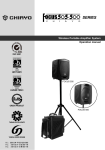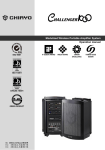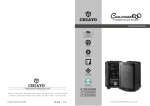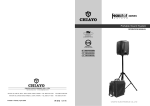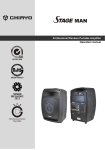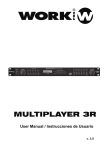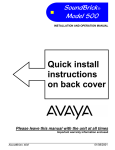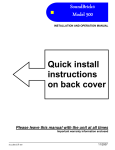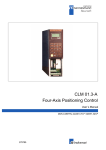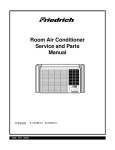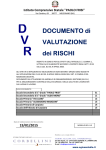Download Chiayo Focus 505 Manual - BSS Light Audio Visual
Transcript
Portable sound system Operation maunal Focus 505 Taiwan Good Design Taiwan Excellence IC: 3563A-FOCUS505 IC: 3563A-SQ5016 IC: 3563A-SM5016 Focus 500 Congratulations and thank you for purchasing this all-in-one compact portable sound system. To ensure a trouble-free operation, please read this manual thoroughly and fully understand its controls and functions. There are various versions of the Focus as below: 1. Focus Passive Speaker.(p.2) 2. Focus Active Speaker.(p.2) 3. Focus with Amplifier.(p.3) 4. Focus with CD / USB Player.(p.3) 5. Focus with CD / USB Player & Digital Recorder.(p.4) 6. Focus with Digital Recorder.(p.4) All the versions can be equipped with 1 or 2 wireless receiver module(s). The wireless receiver module can be VHF, UHF or infrared(IR). The VHF or IR module is a fixed crystal single frequency type whereas the UHF module is a PLL synthesized type with 16 preset frequencies (identified by external 16 channel rotary switch(s)) or crystal fixed. Configuration All versions of Focus series comes equipped with the following: 1. A switch mode power supply. 2. One or two wireless microphones (except non-wireless versions). Optional accessories 1. Carrying bag 2. Tripod stand 3. Wall bracket 4. UHF/Infrared transmitter charger 5. Focus active speaker / passive speaker 6. Wired microphone Remark Manufacturer reserves the rights to change the above combinations without prior notice. -1- Focus Active Speaker 1. Aux volume 2. Aux input 3. Battery low indicator 4. Charging indicator 5. DC in 6. Fuse 7. Power switch 8. Battery compartment release 1 3 2 4 5 6 7 8 8 Focus Passive Speaker 1. Audio input 2. Battery compartment release 1 2 2 -2- Focus (Amplifier version) 1. Mic volume control 2. Aux volume control 3. Wireless mic 1 4. Wireless mic 2 5. Bass control 6. Treble control 7. Voice priority 8. Mic input 9. Aux input 10. Aux output 11. External speaker 12. WR1 channel selector 13. WR2 channel selector 14. Battery low indicator 15. Charging indicator 16. DC in 17. Fuse 18. Power switch 19. Battery compartment release 1 2 3 4 5 6 14 7 8 9 10 11 12 13 15 16 17 18 19 19 Focus (CD / USB Player version) 1. LCD Display 2. Play/Pause 3. Stop 4. Skip 5. Eject 6. CD mode 7. USB mode 8. Folder skip 9. IR LED 10. USB input 11. Power/Volume control 23 4 5 1 11 6 7 8 9 10 -3- Focus (CD / USB Player & Digital Recorder version) 1. Play/Pause 2. Stop 3. SD/USB selector 4. Track number button "1" 5. Track number button "10" 6. Track number button "100" 7. A→B play section 8. Program/Repeat 9. Forward 10. Reverse 11. Folder selector 12. Volume control 13. USB 2.0 input 14. SD card input 15. Copy 16. Record 17. Infrared detector 18. Power on/off 19. Delete 20. LCD display 18 19 17 16 15 654321 20 14 Focus (Digital Recorder version) -4- 11 10 9 8 7 12 13 Operating procedures After unpacking the unit for the first time, please charge the unit for about 4~5 hours before any operation. This is absolutely necessary as the built-in rechargeable battery might have been discharged naturally due to long shipment and storage time, even though it has been fully charged in the factory prior to shipment. To charge the battery, just plug in the DC end of the switch mode power supply into the DC IN of the unit and charging will start automatically. The charging indicator LED flashes RED during the charging process. When GREEN LED stays glowing, the battery is then fully charged and operation could now be started. To operate this portable sound unit, switch on the main POWER, which will glow GREEN. However, the main POWER switch does NOT switch on the WR module, CD / USB player and Digital Recorder as each of them has a dedicated Power / Volume control switch indicated by WR1, WR2. CD/USB Player and Digital Recorder have individual power switch on its panel. When the Charging / Battery Status Indicator glows RED, it means the built-in rechargeable battery is weak and needs to be charged. While charging, the unit could also be operated simultaneously. Operating the built-in Wireless (WR) receiver modules On the Focus control panel, there are two designated power switch / volume control knobs for the built-in Wireless Receiver (WR). They are indicated by WR1 and WR2. To use the 1st wireless microphone, switch on the WR1 power cum volume control switch, Red LED next to it will glow. Switch on the corresponding transmitter (RF). Rotate the volume control knob clockwise and amplified sound could be heard if voice is spoken into the transmitter. To use the 2nd wireless microphone, switch on WR2 power cum volume control switch and repeat the same operation as above. Operating the dynamic wired microphone. To use a cable microphone, simply plug it into any MIC IN socket. Rotate the dedicated volume control knob and master volume control, amplified sound could be heard from the speaker when voice is spoken into the cable microphone. Operation of system with CD / USB Player. This operation is valid for version of Focus with built-in “CD / USB Player”. To operate, first turn on the Master power switch and then turn on the CD power cum volume control switch a little until LED next to it glow. The LCD panel on the player will be lighted up and operation is ready. To insert a CD, just push it into the CD slot and the mechanism will suck it in automatically. Rotate the Power cum Volume control knob to adjust the volume of the player. For Bass and Treble setting, adjust the designated controls respectively. Clockwise direction to either control is to boost and counterclockwise is to back off its level. For more details, please refer to the explanation on “CD / USB Player “controls and functions. -5- Operation of system with Digital Recorder. This operation is valid for version of Focus with built-in “Digital Recorder “. To operate, first turn on the Master power switch and then press the designated power button of this module. The LCD display will be lighted up and Volume setting can be done by rotating the knob. For Bass and Treble setting, adjust the designated controls respectively. For more details, please refer to the explanation of “Digital Recorder “controls and functions. FCC Caution: To assure continued compliance, any changes or modifications not expressly approved by the party responsible for compliance could avoid the user’s authority to operate this equipment. (Example - use only shielded interface cables when connecting to computer or peripheral devices. This device complies with Part 15 of the FCC Rules and RSS-123 of Canada. Operation is subject to the following two conditions: (1)This device may not cause harmful interference, and (2)this device must accept any interference received, including interference that may cause undesired operation. -6- Operating the CD / USB Player To begin operation switch on the CD Power after the main power of Focus has been turned on. Keys PLAY/PAUSE Functions When this key is pushed during CD stop, play will start after track search. When this key is pushed during CD is playing, it will be changed to pause. When this key is pushed during CD is pausing, it will be changed to play. STOP When CD is not stop, if this key is pushed then CD will stop. CD When press this key will change to cd-mp3 mode. USB When press this key will changed to USB mode. SKIP+UP/CUE In stop mode: Change the starting play track (file) during stop mode, cyclic to the first track, if it is in the last track. In program entry mode: Change to the next track(file) for program select . In play mode, pause mode, program play mode, random play mode: Single pressed, skip the playing track (file) to next track(file) for normal play/pause mode, to next program index track(file) for program play/ pause mode, to next random track(file) for random play /pause mode. Continue pressed , fast forward during play/pause when pressed more than 0.7sec. SKIP-DONW/REV In stop mode: Change the starting play track (file) during stop mode, cyclic to the last track, if it is in the first track. In program Entry mode: Change to the previous track (file) for program select. In play mode, pause mode, program play mode: Single pressed, skip the playing track (file) to precious track (file) for normal play/pause mode, to previous program index track (file) for program play/pause mode. Continue pressed, fast reverse during play/pause when pressed more than 0.7sec. FOLDER-UP In stop mode: Skip the starting play folder to next folder during stop mode, cyclic to the first folder if it is in the last folder. In program entry mode: Change the file for program select to next folder’s first file, cyclic to the first folder if it is in the last folder. In normal play mode: Skip the playing file to the next folder’s first file. -7- FOLDER-DOWN PLAY MODE EJECT PROG MUTE POWER ESP FIND 0~10 VOL.VOL.+ In stop mode: Skip the starting play folder to previous folder during stop mode, cyclic to the last folder if it is in the first folder. In program entry mode: Change the file for program select to previous folder’s first file, cyclic to the last folder if it is in the first folder. In normal play mode: Skip the playing file to the previous folder’s first file. In mp3 mode and in USB mode . If this key is pushed, PLAY mode is changed cyclically shown below. PLAY ALL RANDOM→REPEAT TRACK→REPEAT FOLDER→ REPEAT ALL→RANDOM REPEAT→PLAY ALL IN CD mode If this key is pushed, PLAY mode is changed cyclically shown below. PLAY ALL RANDOM→REPEAT TRACK→REPEAT ALL→ RANDOM REPEAT→PLAY ALL. When this key is pushed, door is moved out. Set to programming mode. When programming mode, “stop” key is pushed then program is all cleared. When this key is pushed during CD is playing, the set will mute the output. Pushing again can recovery the output. Power SW of the set. In CDDA mode, Press ”ESP” key, The ESP display lighted and the set is in electronic anti-shock state. The electronic anti-shock time is about 40 seconds. Press “ESP” key again, cancel the ESP function. In MP3 mode : Press this key once FILE search mode changed . Press this key twice ALBUM search mode changed. Long press this key to display the track. Press twice to display ID3 TAG. You can use these keys to select the track you want directly. When this key is pushed, the volume will decrease by 1dB per step, the min. volume is 0dB. When this key is pushed, the volume will increase by 1dB per step, the max. volume is 30dB. Caution: This player does not accept 8-cm diameter CD. User is advised to have the USB 2.0 formatted in “ FAT “ or “ FAT 32 “. The built-in USB 2.0 player can not be able to read the MP3 files stored in your USB if it is not formatted by either “ FAT “ or “ FAT-32 “. To avoid damage to the USB, remember to detach it only after switching off the player. -8- Operating the Digital Recorder Player Features - Recording through the Line-in recording directly to a USB or SD Card - Offer USB and SD Card function of each replication. - Recording format is most popular MP3 audio format. - Accept the capacity of 128MB to 16G USB / SD Card / SDHC - With a language learning function, can be broadcast repeatedly at designated areas - Adjustable recording quality, provide choice of 44.1 KHz, 128 Kbps and 192Kbps. - Able to store up to 99 folders, or 999 tracks in SD Card or USB Easy to use - Play through the LINE IN audio recording files into the directory folder simply select "REC" - Play copied USB or SD Card copy files into the directory folder simply select "CPY" - Direct delete function when plan single song - Can copy single, multiple songs or whole folder Operation and function of the use of panel description POWER: Switching power on / off. VOLUME: Volume control button, turning to adjust the volume USB socket: To insert a USB storage device SD CARD socket: To insert a SD CARD 100 / 10 / 1: The number buttons to select directory, or track. - Button 1, indicating the single digit 1 to 9, press once to increase every 1 single digit. - Button 10, indicating the 10-digit, press once to increase every 10-digit. If total tracks are 88, the LCD display will only show to “8”. Keep pressing will back to “0”. - Button 100, indicating the 100-digit, press once to increase every 100-digits. If the total tracks below the 100, the button has no effect. FOLDER: Folder selection key and adjust the recording quality -Select folder Press FOLDER button, LCD screen display F, then REW or F. FWD button with the numbers 0 to 9 button to select the directory . Double-click the Cancel catalog select, LCD screen, "F" disappears -Recording quality adjustment: Press FOLDER button more than 3 seconds can choose the recording quality. Press REW or F. FWD key to select 44.1 KHz,128Kbps or 192Kbps Recording ■REC: Recording function key, need to use this key to record through the Line-in channel When USB and SD Card are both in the device - Press the REC button. LCD display flashing to indicate will be recorded to USB or SD. - Use USB / SD button to select the option to record to USB or SD card. - Press REC to start to recording, LCD starts to flashing indicated that they are recording - Press STOP button to stop recording. When only single USB or SD Card in the device - Press REC to begin recording, LCD starts to flash and indicating that they are recording, -9- press STOP button to stop recording. Sound recording through the REC function keys are saved in the directory folder REC -To Play REC track in folder: press FOLDER button, LCD display F. Use REV or F. WD button to select the directory REC, press PLAY / II to start playing. -The track number in the REC Folder will start from “ REC 001 “, and increase gradually. Therefore if want to check the recording file after finish record, the song will be recorded at the last track in the REC folder. COPY: Copy function key. It has to operate copy function in STOP status when use this key for USB Copy to SD or SD Copy to USB. Press STOP key, the device should be at stop mode Insert USB and SD Card, use USB / SD button to select the device you want to copy the source of any of the following options Copy single: Press REV , F. WD button or Numerals key to select tracks. Press COPY button to start copying Copy the multi-tracks or multi-directories: - Select the tracks and store the tracks in the Memory Program first(for PROG feature instruction, please refer to PROG) - Press COPY button to copy the tracks stored in the Program, if the copy to SD, LCD display will flash SD and indicates that it is recording to the SD card. Copy the whole directory: - Press FOLDER button, LCD display F, use REV button & F. WD to select the directory you want to copy - Press COPY key to start to copy the selected directory. If copy to SD, LCD display will flash SD and indicates that it is recording to the SD card. - The tracked recorded through COPY function are stored in the folder “CPY” - To play folder “CPY” of the tracks, press FOLDER button, LCD display F. Press REV keys F. WD button to select the directory CPY, press PLAY / II to start playing - The time required to copy according to the file size and track the numbers -Copy function is copying without folder. For example, if wants to copy each 5 tracks in 3 folders (total 15 tracks) and there will be storage to CPY001 ~ CPY015 at the CPY folder after copying. If copy a new song after it, it will be storage at CPY016. A↔ B: Section Repeat Play Press once to start playing the beginning of memory. Press again to stop at the end of memory area. The device repeats to play memory area. Press it again to stop playing. USB / SD Playing ■PLAY/II: Play and pause, press to play, play again to pause. ■STOP: Press to stop playing ■USB / SD: Select to use US or SD CARD ■REPEAT /PROG: Press to select Repeat or Program memory function Repeat function : Need to operate in the playing mode - Press once, LCD screen displays "REP", will repeatedly playback currently playing track. - Press twice, LCD screen displays "REP F", will repeat the entire directory is currently -10- being played - Press 3rd times, LCD screen displays "REP ALL", will be repeated play all tracks. - Press 4th times, cancel repeat playback function. The words on LCD screen will be eliminated. Memory function: Need to operate in the stop-play mode, can be memories up to 99 songs - Single or multi-tracks memory: Press the STOP button to stop playback. Press PROG / REPEAT button, LCD screen displays PROGRAM. Select desired songs by using FOLDER button and number keys 0 to 9 and REV key or F. WD key. Press PROG / REPEAT button to store 1st song, LCD display shows “00 01” for the 1st song. Press << PROG / REPEAT >> again for storing 2nd song; LCD display shows “00 02”. Start over above process for storing more songs. Press PLAY / II memory to play the tracks stored in the Program. -Whole folder memory: Press the STOP function keys to stop playback Press PROG / REPEAT button, LCD screen display shows PROG, press the FOLDER button with the number of combination of keys or REV keys F. WD button to select the folder Press PROG to store selected folder. To store more folders, repeat above steps. Press PLAY / II button to start play memorized folders. To memorize multi-folders or multiple tracks, repeat above steps LCD will display shows FULL when stored 99 songs To cancel program feature, keep pressing PROG button until LCD display PROG disappeared ▼ ▼ ▲ ▲ ■REV I : Backwards. Press to backward to last track. Press for 3 seconds to fast reverse the track ■F. WD I: Fast forward. Press to forward to next track. Press for 3 seconds to fast forward the track ■IR sensor: Infrared remote control eye. ■DEL: Delete single / folder / all of the files. Delete current playing track, can be operated under “Stop” mode or during “Playing” mode Press DEL button, LCD displays flash DEL FILE, reminding you to delete the file, and then press DEL to confirm the deletion, LCD display shows DEL END. Delete a folder: To delete the specified folder, press FOLDER button to select the folder you want to delete, click the DEL, LCD display flashes DEL FOLDER , reminding whether you want to delete the folder, and then press DEL again to confirm the deletion, LCD displays DEL END, the folder is removed Delete all the files: In the stop-play mode operation - Press the Stop button - Long DEL key to more than 5 seconds - LCD display shows "DEL ALL" to confirm whether you want to delete all the files - Then press DEL key again to delete all the files -11- - To cancel delete function, just wait for LCD stops flashing and cancellation of delete function LCD Display: ▼ LINE: Line in audio source DEL: When using delete function : In playing mode II: Pausing REP: Repeatedly playing the single track REP ALL: Repeat all tracks REP F: Repeat specific folder RAN: Playback in random order PROG: When operate to program tracks. M: Mute function A→B: When repeat playing a specific section USB: When use USB function SD: When use SD card function COPY: When operate copy function REC: When operate recording function : The volume display, total 15 sections. 888(1st): Under the MP3 mode, it will appear the folder numbers. 888(2nd): Display the current playing track. 88:88:88:Display the time for the current playing track. THE FUNCTIONS ON THE REMOTE CONTROLLER The remote controller shall be appointed to the receiving hole of face plate. The optimal receiving distance is 3 meters. ( the available distance is 3 meters. ) The batteries ( model CR2025 3V ) shall be put into the remote controller. ■Numeral 0 ~ 9 : Select the track from numerals. ■USB / SD: Switching for USB or SD mode. ■REC: Recording function buttom, use for LINE IN recording. When both USB and SD Card are both in the device - Press the REC button. LCD display flashing to indicate will be recorded to USB or SD. - Use USB / SD button to select the option to record to USB or SD card. - Press REC to start to recording, LCD starts to flashing indicated that they are recording - Press STOP button to stop recording. When only single USB or SD Card in the device - Press REC to begin recording, LCD starts to flash and indicating that they are recording, press STOP button to stop recording. Sound recording through the REC function keys are saved in the directory folder REC - To Play REC track in folder: press FOLDER button, LCD display F. Use REV or F. WD -12- button to select the directory REC, press PLAY / II to start playing. - The track number in the REC Folder will start from “ REC 001 “, and increase gradually. Therefore if want to check the recording file after finish record, the song will be recorded at the last track in the REC folder. COPY: Copy function key. It has to operate copy function in STOP status when use this key for USB Copy to SD or SD Copy to USB. Press STOP key, the device should be at stop mode Insert USB and SD Card, use USB / SD button to select the device you want to copy the source of any of the following options Copy single: Press REV , F. WD button or 0 ~9 Numerals key to select tracks. Press COPY button to start copying Copy the multi-tracks or multi-directories: - Select the tracks and store the tracks in the Memory Program first(for PROG feature instruction, please refer to PROG) - Press COPY button to copy the tracks stored in the Program, if the copy to SD, LCD display will flash SD and indicates that it is recording to the SD card. Copy the whole directory: - Press FOLDER button, LCD display F, use REV button & F. WD to select the directory you want to copy - Press COPY key to start to copy the selected directory. If copy to SD, LCD display will flash SD and indicates that it is recording to the SD card. - The tracked recorded through COPY function are stored in the folder “CPY” - To Play folder “CPY” of the tracks, press FOLDER button, LCD display F. Press REV keys and F. WD button to select the directory CPY, press PLAY / II to start playing - The time required to copy according to the file size and track the numbers - Copy function is copying without folder. For example, if wants to copy each 5 tracks in 3 folders (total 15 tracks) and there will be storage to CPY001 ~ CPY015 at the CPY folder after copying. If copy a new song after it, it will be storage at CPY016. ■REP: Repeat function : Need to operate in the playing mode - Press once, LCD screen displays "REP", will repeatedly playback currently playing track. - Press twice, LCD screen displays "REP F", will repeat the entire directory is currently being played - Press 3rd times, LCD screen displays "REP ALL", will be repeated play all tracks. - Press 4th times, cancel repeat playback function. The words on LCD screen will be eliminated. ■PROG Memory function: Need to operate in the stop-play mode, can be memories up to 99 songs - Single or multi-tracks memory: Press the STOP button to stop playback. Press PROG / REPEAT button, LCD screen displays PROGRAM. Select desired songs by using FOLDER button and number keys 0 to 9 and REV key or F. WD key. Press PROG / REPEAT button to store 1st song, LCD display shows “00 01” for the 1st song. Press << PROG / REPEAT >> again for storing 2nd song; LCD display shows “00 02”. Start over above process for storing more songs. Press PLAY / II memory to play the -13- tracks stored in the Program. - Whole folder memory: Press the STOP function keys to stop playback Press PROG / REPEAT button, LCD screen display shows PROG, press the FOLDER button with the number of combination of keys or REV keys F. WD button to select the folder Press PROG to store selected folder. To store more folders, repeat above steps. Press PLAY / II button to start play memorized folders. To memorize multi-folders or multiple tracks, repeat above steps LCD will display shows FULL when stored 99 songs To cancel program feature, keep pressing PROG button until LCD display PROG disappeared ▼▲▼▲ ▼▲▼▲ STOP: Press to stop playing I : Press to backward to previous track I: Press to forward to next track Press to fast reverse the playback. Press again to cancel fast reversing Press to fast forward the playback. Press again to cancel the fast forwarding DEL: Delete single / folder / all of the files. Delete current playing track, can be operated under “Stop” mode or during “Playing” mode Press DEL button, LCD displays flash DEL FILE, reminding you to delete the file, and then press DEL to confirm the deletion, LCD display shows DEL END. Delete a folder: To delete the specified folder, press FOLDER button to select the folder you want to delete, click the DEL, LCD display flashes DEL FOLDER , reminding whether you want to delete the folder, and then press DEL again to confirm the deletion, LCD displays DEL END, the folder is removed Delete all the files: In the stop-play mode operation - Press the Stop button - Long DEL key to more than 5 seconds - LCD display shows "DEL ALL" to confirm whether you want to delete all the files - Then press DEL key again to delete all the files - To cancel delete function, just wait for LCD stops flashing and cancellation of delete function ■RAN: Press to play the tracks in a random order. Press again to cancel. ■FOLDER: Folder selection key and adjust the recording quality - Select folder Press FOLDER button, LCD screen display F, then REW or F. FWD button with the numbers 0 to 9 button to select the directory . Double-click the Cancel catalog select, LCD screen, "F" disappears - Recording quality adjustment: Press FOLDER button more than 3 seconds can choose the recording quality. Press REW or F. FWD key to select 44.1 KHz, 128Kbps or 1 92Kbps ■PLAY / II: Play and pause, press to play, play again to pause ■MUTE: Press to mute, press again to back to normal playing -14- UHF/VHF handheld microphone (Q-1005/Q-815/SQ-1016/SQ-5016) Parts and functions 1 2 3 4 5 ▲ Q-1005 (VHF fixed freq.) 1 2 3 4 5 Q-815 ▲ 6 (UHF fixed freq.) 1 2 3 4 5 6 ▲ SQ-1016 7 (UHF 16 freq.) 1 2 3 4 5 6 10 7 11 8 9 ▲ SQ-5016 (UHF LCD 16 freq.) Microphone parts and functions Cartridge Battery power LED Power switch Channel switch LCD Battery compartment Bottom cap Locking button Setting button Up button Down button Charging port VHF Q-1005 1 2 3 4 5 - Q-815 1 2 3 4 5 6 -15- UHF SQ-1016 1 2 3 4 5 6 7 SQ-5016 1 2 3 4 5 6 7 8 9 10 11 Battery installation This microphone requires 2 AA-size batteries to operate. Please insert the batteries according to the correct polarity. Many batteries are known to have leakage problem of conductive and corrosive liquid. Please observe the rule to remove the batteries if they are not to be used for a longer period. Channel setting (SQ-1016) Use the attached small screw driver to set the channel and the channel number will show on the window above it. Other settings(SQ-5016) 1. Channel setting Use UP or DOWN button to go to the CHANNEL/ FREQUENCY page. The cursor will flash to allow changes to be made. Pressing UP or DOWN button will increase or decrease the channel number. The corresponding frequency will change accordingly. When a desired channel is selected, it will be automatically saved and stored in the memory. 2. Making changes to Battery selection Use UP or DOWN button to go to the Battery selection page. Press UP or DOWN button to move the cursor to either NiMH (rechargeable battery) or AKLN (Alkaline battery) position. When the desired battery has been selected, it will be automatically saved and stored in the memory. Remark : NiMH battery must be selected when rechargeable battery is being used. Never select AKLN (Alkaline) when microphone is intended for charging as Alkaline battery can not be charged ! Wrong selection of battery will result in battery sensing electronics to display wrong and misleading status information. 3. Making changes to Sensitivity Level Use UP or DOWN button to go to the SENS SET page. Press UP or DOWN button to increase or decrease the Sensitivity Level of the microphone. The MAX level is 4 and the MIN level is 1. When a desired sensitivity level has been selected for your application, it will be automatically saved and stored in the Memory. Remark : When selecting Sensitivity level, please bear in mind that Level 1 is for close proximity singing purposes whereas Level 4 is for use of microphone on tripod mount for speech purposes. When Level 4 setting is used for close proximity singing, high SPL input will result in undesirable distortion in the output. After performing setting changes, you could turn the protective cover 180° in either direction to block the buttons from being accidentally adjusted. -16- UHF/VHF beltpack transmitter (M-1005/M-815/SM-1016/SM-5016) Parts and functions 1 2 3 4 1 2 3 4 2 3 6 5 M-1005 ▲ (VHF fixed freq.) 7 6 11 14 15 8 5 5 6 4 12 13 10 M-815 ▲ 9 SM-5016 ▲ (UHF fixed freq.) (UHF LCD 16 freq.) SM-1016 ▲ (UHF 16 freq.) Transmitter parts and functions Antenna Battery weak / audio mute indicator Power switch Mini-XLR connector Audio mute switch LCD Charging port Cover release button Charging contacts Lavalier microphone Setting button Up button Down button Channel switch Gain control (GT, hign impedance) Gain control (MT, low impedance) VHF M-1005 2 M-815 1 2 UHF SM-1016 1 2 SM-5016 1 2 3 4 5 9 6 12 3 4 5 9 6 12 3 4 8 9 10 11 12 5 4 3 6 7 8 9 10 11 12 13 14 13 13 13 15 -17- Battery installation This microphone requires 2 AA-size batteries to operate. Please insert the batteries according to the correct polarity. Many batteries are known to have leakage problem of conductive and corrosive liquid. Please observe the rule to remove the batteries if they are not to be used for a longer period. Channel setting (SM-1016) and sensitivity setting Use the attached small screw driver to set the channel and the channel number will show on the window above it. Gain control is an adjustable design that enables user to set different output levels. GT is for the use of instrument with high impedance, such as guitar while MT is for the use of low impedance such as lavalier or headset microphone. To adjust the audio input levels, simply use a small screw driver to rotate to a desired level. Other settings(SM-5016) 1.Channel setting Use UP or DOWN button to go to the CHANNEL/ FREQUENCY page. The cursor will flash to allow changes to be made. Pressing UP or DOWN button will increase or decrease the channel number. The corresponding frequency will change accordingly. When a desired channel is selected, it will be automatically saved and stored in the memory. 2. Making changes to Battery selection Use UP or DOWN button to go to the Battery selection page. Press UP or DOWN button to move the cursor to either NiMH (rechargeable battery) or AKLN (Alkaline battery) position. When the desired battery has been selected, it will be automatically saved and stored in the memory. Remark : NiMH battery must be selected when rechargeable battery is being used. Never select AKLN (Alkaline) when transmitter is intended for charging as Alkaline battery can not be charged ! Wrong selection of battery will result in battery sensing electronics to display wrong and misleading status information. -18- Infrared handheld microphone (IWH-201/IWH-301) Parts and functions 1 2 3 4 5 7 6 1. Grille cover. 2. Status LED: Bicolor LED will glow when switch is put to ON. Green : Battery is full and microphone is in normal mode. Red : Battery is weak and will shut off soon. Please charge the battery. 3. Power switch. Slide to turn microphone on or off. 4. Battery compartment. 5. Infrared emitter with charging contacts. IR ray radiates from here. Do not block or hold this part of the body. 6. Channel selector (IWH-301). A stands for 2.08MHz and B stands for 2.54MHz. Power Selector Switch (Lo/Hi)(IWH-201). This switch changes transmitting intensity of infrared ray. At Lo position transmitting distance is about 20M and at Hi position about 30M.If transmission system may pick up some noise at Lo position, it means the transmitting distance may be insufficient. Please switch to Hi position. Factory setting is Lo position.At Hi power operation, operating time is about 4 hours. (About half time of Lo power operation.) 7. Sensitivity control. Clockwise to increase sensitivity level. Factory preset is max level. Battery installation/replacement Turn the battery cover counterclockwise and pull out. Make sure the power switch is in OFF position when installing or replacing batteries. And then install the new battery according to its correct polarity. 1 NiMH battery 2 sleeved AA batteries OR -19- Infrared handheld/pendant microphone (IWH-401) Parts and functions 1 2 3 4 5 8 9 7 6 1. Cartridge screen. 2. Infrared emitter. IR ray radiates from here. Do not block or hold this part of the body. 3. Anti-rolling color ring. 4. Status LED: Bicolor LED will glow when switch is put to ON : Green : Battery is full and microphone is in normal mode. Red : Battery is weak and will shut off soon. Please charge the battery. 5. Power switch Slide to turn microphone on or off. 6. Charging contact, workable with HC-40 charger. This microphone has a unique inbuilt safety feature to protect itself from misuse during recharging. It incorporates a special charging function which will only operates when the PVC cover of the battery is removed . Any rechargeable batteries used must be prepared in this way to operate the recharge function. 7. Battery compartment. Turn the battery cover counterclockwise and pull out. Make sure the microphone is turned off when installing or replacing batteries. And then install the new battery according to its correct polarity. IWH-401 uses only 1 AA battery to operate. 8. Channel selector. A stands for 2.08MHz and B stands for 2.54MHz. 9. Sensitivity control. Clockwise to increase sensitivity level. Factory preset is max level. Making changes to settings in IWH-401 Battery installation/charging Rotate off the battery cover and install 1 AA battery. Please make sure the battery type is rechargeable if it's to be charged by the charger. Its rechargeable battery can be charged by HC-40 without being removed from the microphone. If the microphone is not to be used for long time, please remove the battery until next use. peeled off AA-sized NiMH battery -20- Infrared beltpack transmitter (IWM-202) Parts and functions 1. Battery compartment 2. Power high/low switch 3. A-B channel selector 4. Lavalier or headset microphone input 5. Power on/off 6. Power indicator 7. Infrared emission source 8. Volume control 4 8 6 7 3 2 5 1 Operating procedures 1. Open battery cover and put 2 AA alkaline batteries. 2. Connect with lavalier or headset microphone input. 3. Power the transmitter to make the power indicator turn green. If red or remaining off, it means power shortage or no power. Please replace with new batteries. Generally two alkaline batteries can last 5~6 hours. 4. Adjust amplifier volume control. 5. Never cover with infrared emission source. Custom made rechargeable Ni-MH battery 1. This battery is exclusively designed for the infrared wireless microphone. 2. Be sure to charge the attached battery before use. 3. For surely you do not recharge the battery before full discharge. 4. Keep clean the charge terminal, otherwise you may not charge the battery. 5. Do not repeatedly recharge the battery before full discharge, if you repeat above, battery life will be shortened. 6. Battery life is around one year or 500 recharge cycles under normal operation. Once noticing that operating time becomes shorter even full charging, the battery is exhausted. 7. Replace with new batteries. (Be sure to use exactly same type as attached.) Battery operating time Continuous operating time of fully charged NiMH batteries is as below. position of power selector operating time Low 6 hours High 4 hours -21- Infrared beltpack transmitter (IWM-302) Parts and functions 5 1 2 3 4 8 6 10 9 7 1. Volume control 2. Power on / Battery-status indicator 3. Power switch 4. Mini XLR connnector 5. Infrared emitter 6. Cover-release button 7. Charging contacts 8. Transmission-strength selector 9. Channel selector 10. Gain control (MT, low impedance) Making changes to settings in IWM-302 Channel changing First open the cover of IWM-302's battery compartment by pressing its release buttons on both sides. There are 2 channels for selection, namely "A" and "B", either can be chosen by switching this selector. MT adjusting Low-impedance "MT" gain control is situated inside the battery compartment. It can be adjusted by using a small screw driver to rotate till a desired audio output level has been selected. Battery installation To install the batteries, first open the battery compartment by pressing the release buttons on both sides of the IWM-302. Batteries used are 2 pcs of NiMH type (rechargeable) or Alkaline type (not rechargeable). When inserting batteries, please place them according to the correct polarity. -22- Infrared pendant transmitter (IWM-402) Parts and functions 5 1 8 2 9 10 peeled off 11 3 4 6 7 AA-sized NiMH battery 1. Mic in (Φ2.5mm). Headset or lavalier microphone is ok. 2. Power switch. 3. Charging port. 4. Charging contact, workable with HC-40 charger. This transmitter has a unique inbuilt safety feature to protect itself from misuse during recharging. It incorporates a special charging function which only operates when the PVC cover of the battery is removed. Any rechargeable batteries used must be prepared in this way for the recharge function to operate. 5. IR emitter area. IR ray radiates from here. Do not block or hold this part of the body. 6. Status LED: Bicolor LED will glow when switch is put to ON : Green : Battery is full and transmitter is in normal mode. Red : Battery is weak and will shut off soon. Please charge the battery. 7. Mute. Press this button to mute/resume audio transmission. 8. Volume control. 9. Line in (Φ3.5mm), for external audio input. 10. A-B channel switch. 11. Battery compartment. IWM-402 uses only 1 AA battery to operate. Making changes to settings in IWM-402 Channel changing First open the cover of IWM-402's battery compartment on its rears. There are 2 channels for use and can be changed by sliding the A-B channel switch. Battery installation/charging To install the batteries, first open the battery compartment on IWM-402's rear. It uses only 1 AA battery to operate. It accepts NiMH rechargeable battery or Alkaline battery. If rechargeable battery is used, it can be charged by HC-40 charger. -23- Maintenance-free Lead Acid battery Guidelines for maintenance-free Batteries: 1. Battery should operate at temperatures between 15°C ~ 50°C. To ensure a longer life span, it should be kept between 5°C ~ 35°C. For optimum result, 20°C ~ 25°C will be ideal. When temperature falls 15 degrees below zero, battery will undergo some changes in its chemical contents and therefore cannot be recharged. Operating the battery at higher temperature will result in higher capacity but shorter lifespan, whereas lower temperatures operation has a longer lifespan but less capacity. 2. If the battery is not recharged 72 hrs after it is completely used, it will be permanently damaged. 3. When the battery is being charged, the internal gases will be electrolyzed into water at the negative charge, maintaining the battery’s storage abilities with no water added. However, erosion at the charged ends of the battery will cause poor performance. 4. The battery’s cycle lifespan (no. of charge and discharge cycle) is determined by the degree at which power is dissipated., especially the degree of discharged each time it is used and the recovery charging method. For normal use, the battery can be used for longer hours when less power is dissipated each time and vice versa. At 25°C, maintenance-free batteries could be charged 150 ~ 200 times at 100% discharge each time. 5. Decrease in capacity, internal short circuit, deformation in appearance, erosion of charged ends and decrease in open circuit voltage are symbols indicating battery is approaching the end of its life cycle. 6. When two batteries are used in parallel connection, the resistance of the cables should be kept equal. Properties of the Lead Acid Battery: 1. Has no memory effect. Can be charged at anytime, even when the recharge indication light is not on. 2. Performance and efficiency are affected by changes in the environment, especially temperature and humidity. (Best operated between 20°C ~ 25°C) 3. Battery discharge naturally according to a certain pattern even not in use. For best performance and a prolonged lifespan, it should be recharged every month even when not in use. 4. Under normal circumstances, battery could last for about a year. 5. When the battery’s life expires, possible indicators include internal short-circuit, decrease in capacity, deformation in appearance, erosion of charged ends and decrease in operating voltage. User’s Precautions: 1. For first-time use, charge the battery for 10 hrs until it is fully charged. 2. To maintain performance and lifespan, if product has not been used for 3 months after the initial shipment, please fully charge the battery. 3. Before each use, it’s advisable to charge the battery to its full capacity. 4. The average lifespan of the battery is one year. The user is advised to change the battery after one year of use. 5. The current consumption is in direct ratio with load current. The more current consumption, the less the operation time. -24- -25- -26- 12I1240




























